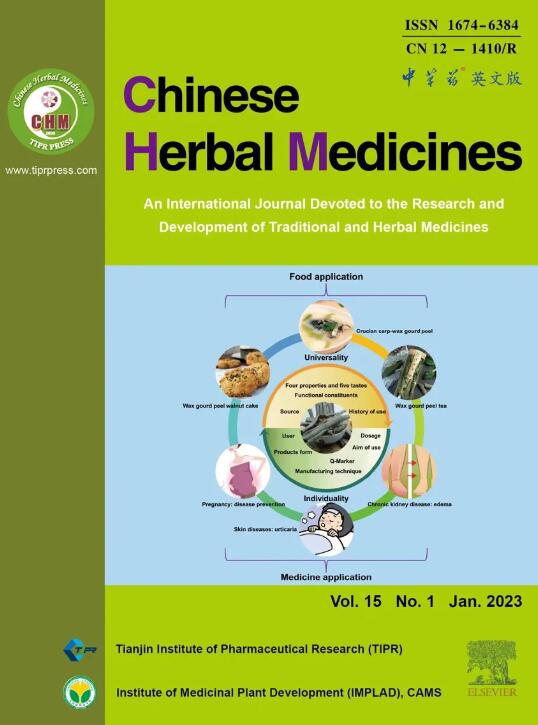Anthraquinones of Cassiae Semen alleviate lipid accumulation in obesity by regulating brown adipose tissue and liver function
IF 8.9
4区 医学
Q1 CHEMISTRY, MEDICINAL
引用次数: 0
Abstract
Objective
Cassiae Semen (CS, Juemingzi in Chinese) is a widely used traditional Chinese medicine with a variety of pharmacological effects. This study aimed to investigate the potential therapeutic effects and molecular mechanisms of anthraquinones of CS (AQS) for adiposity.
Methods
The chemical components of the AQS were determined using high-performance liquid chromatography (HPLC). Network pharmacology analysis was used to predict potential anti-obesity targets of action for AQS. We constructed high fat with high sugar water diet-induced obese mice and observed their body weight and whole-body lipid metabolism to evaluate the efficacy of AQS in promoting lipid metabolism. Subsequently, the epidermal temperature at the brown adipose tissue (BAT) before and after cold stimulation was observed and the expression of lipid metabolism-related genes in the liver and BAT tissues was detected to clarify the mechanism of action of AQS.
Results
Network pharmacology analysis showed that AQS was involved in the regulation of liver and adipose tissue function under obesity. Pathological and biochemical results showed that AQS reduced lipid accumulation in the liver and adipose tissue induced by an unhealthy diet. With the increase of cold tolerance, the volume and weight of BAT were increased by AQS, suggesting that it regulated the body heat production dominated by BAT. After AQS treatment, the levels of genes related to uncoupling protein1 (UCP1)-mediated adaptive thermogenesis in BAT tissues and lipid metabolism in the liver were also increased, which further proved that AQS activated BAT function to promote lipid metabolism in the whole body.
Conclusion
This study revealed the pharmacological effects of AQS, thereby providing a scientific basis for regulating BAT thermogenesis and liver lipid metabolism to alleviate obesity and providing clues for further exploring the application of natural active ingredients in the treatment of metabolism-related diseases.
决明子蒽醌类通过调节褐色脂肪组织和肝功能减轻肥胖脂肪堆积
目的觉明子是一种广泛应用的中药,具有多种药理作用。本研究旨在探讨蒽醌类化合物(AQS)对肥胖的潜在治疗作用及其分子机制。方法采用高效液相色谱法测定其化学成分。网络药理学分析预测AQS潜在的抗肥胖作用靶点。我们用高糖水饮食诱导的肥胖小鼠构建高脂模型,观察其体重和全身脂质代谢,评价AQS对脂质代谢的促进作用。随后,观察冷刺激前后棕色脂肪组织(brown adipose tissue, BAT)表皮温度变化,检测肝脏及BAT组织中脂质代谢相关基因的表达,阐明AQS的作用机制。结果网络药理学分析显示,AQS参与调节肥胖肝脏和脂肪组织功能。病理和生化结果显示,AQS可减少由不健康饮食引起的肝脏和脂肪组织的脂质积累。随着耐寒性的提高,AQS增加了BAT的体积和重量,表明AQS调节了以BAT为主的体产热。AQS处理后,BAT组织中解偶联蛋白1 (uncoupling protein1, UCP1)介导的适应性产热及肝脏脂质代谢相关基因水平也有所升高,进一步证明AQS激活BAT功能促进全身脂质代谢。结论本研究揭示了AQS的药理作用,为调节BAT产热及肝脏脂质代谢减轻肥胖提供了科学依据,为进一步探索天然活性成分在代谢相关疾病治疗中的应用提供了线索。
本文章由计算机程序翻译,如有差异,请以英文原文为准。
求助全文
约1分钟内获得全文
求助全文
来源期刊

Chinese Herbal Medicines
CHEMISTRY, MEDICINAL-
CiteScore
4.40
自引率
5.30%
发文量
629
审稿时长
10 weeks
期刊介绍:
Chinese Herbal Medicines is intended to disseminate the latest developments and research progress in traditional and herbal medical sciences to researchers, practitioners, academics and administrators worldwide in the field of traditional and herbal medicines. The journal's international coverage ensures that research and progress from all regions of the world are widely included.
CHM is a core journal of Chinese science and technology. The journal entered into the ESCI database in 2017, and then was included in PMC, Scopus and other important international search systems. In 2019, CHM was successfully selected for the “China Science and Technology Journal Excellence Action Plan” project, which has markedly improved its international influence and industry popularity. CHM obtained the first impact factor of 3.8 in Journal Citation Reports (JCR) in 2023.
 求助内容:
求助内容: 应助结果提醒方式:
应助结果提醒方式:


